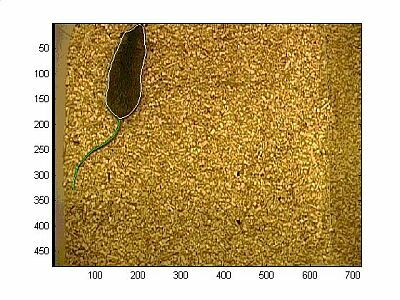
Segmentation and behavioral classification of mice using digital video
S.R.C. Campbell
Intelligent Optical Systems, Torrance, U.S.A.
We present results for the automated classification of three types of mouse behavior on typical bedding material using digital video (30 frames per second). The uniformly coloured brown mouse we use has a smooth texture on this bedding material, so we perform texture segmentation [1] to distinguish the mouse from the background. The segmentation process involves convolution with a texture filter, followed by thresholding. Several steps of erosion are performed to remove the tail from the body, and then several iterative dilations are used to expand the segment to approximate its original contour. The tail is found using a line detection algorithm [2]. In Figure 1, we display a typical image of the mouse with its contour and tail superimposed.

Figure 1. A typical image with body contour and tail localized.
We then perform a straightforward motion analysis to determine when the mouse is active or inactive. To identify grooming, we examine the contour's power spectrum to look for oscillatory activity. The power spectrum is based on a two-second time interval and includes data from one second before and one second after the frame in question. If there is a peak in the power spectrum in the range of 5-10 Hz, the mouse is not elongated, and if the mouse is not active, then the behavior is classified as grooming.
We tested the algorithms on 564 seconds of data from a single mouse (roughly 17,000 images). Both the raters and algorithms classified each second of data into the three following categories: activity, inactivity and grooming. There was 87% agreement between the algorithms and the raters, and 93% agreement between the two human raters. We discuss the computational complexity of the algorithms, the time needed to obtain the results, the difficulties that the algorithms have in finding the tail and the body under specific circumstances, and other possible behaviors that can be determined visually.
References
Paper presented at Measuring Behavior 2002 , 4th International Conference on Methods and Techniques in Behavioral Research, 27-30 August 2002, Amsterdam, The Netherlands